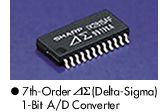The SM-SX1 and
SM-SX100 are based on the class-D amplification system. While conventional
class-D amplifiers use PWM signals with an analogue-like width on the time
axis to control the 'on state' by switching the high voltage, the SM-SX1
and SM-SX100 use precise, quartz crystal accurate 1-bit signals to control
switching of the fixed-voltage power. Pure
sound transmission is achieved through three stages, as seen in Figure 8.
First a 1-bit signal stream with a wide frequency range faithful to the
input signals is created through 2.8224 MHz high-speed sampling by a 7th-order
delta-sigma 1-bit A/D converter. This converter also shifts quantisation
noise to the higher frequency to maintain a wide dynamic range of the signal
in the audible band. Pure
sound transmission is achieved through three stages, as seen in Figure 8.
First a 1-bit signal stream with a wide frequency range faithful to the
input signals is created through 2.8224 MHz high-speed sampling by a 7th-order
delta-sigma 1-bit A/D converter. This converter also shifts quantisation
noise to the higher frequency to maintain a wide dynamic range of the signal
in the audible band. The 1-bit signals are then amplified by the power switching circuit. To avoid decline of the amplified 1-bit signals' voltage power when high level signals are input continuously, delta-sigma dynamic feedback is employed. This circuit senses declines and quickly adjusts the next data by continuously feeding back fluctuations to the 7th-order delta-sigma 1-bit A/D converter, while synchronising with the sampling frequency. As a result, SM-SX1 and SM-SX100 maintain faithful amplification of the input data. At the final stage, the amplified switching signal is converted into an analogue signal used to drive the speakers by a low-pass filter network. From the dynamic expression of a fortissimo from silence at a stroke, to the static expression of the deepening silence of a pianissimo fade-out, SHARP's 1-bit amplifiers have the rare ability to reproduce all music expressions.  |
|
Home
> Products
News > 1-Bit Audio Components > 1-Bit
Amplifier SM-SX1 & SM-SX100
> The 1-Bit Operation Concept |